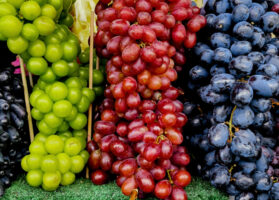Agronometrics in Charts: 2022 : Grapes in Review
In this installment of the ‘Agronometrics In Charts’ series, Sarah Ilyas reviews the 2022 Grape season and studies what 2023 might have in store for table grapes in the US. Each week the series looks at a different horticultural commodity, focusing on a specific origin or topic visualizing the market factors that are driving change.
The USDA anticipates that after three years of reduced output, US table grape production will climb by 24,000 tons to 850,000 tons in the 2022–2023 growing season. This forecast represents only a slight increase as drought and frost precluded a more robust recovery and growers continue to face labor and water availability issues. California witnessed a turbulent growing season in 2022 owing to intense heat, which led to challenging growing conditions and higher input prices, leading to a strain on profits. In the August 2022 Crop Production report, USDA’s NASS projected that higher supplies from Peru and Chile would boost imports by 32,000 tons to 745,000 at the beginning of the May-April marketing year for the 2022-23 season.
Grape Volumes By Origin in the US

Source: USDA Market News via Agronometrics.
(Agronometrics users can view this chart with live updates here)
As dispatches started trickling in around May, the Peruvian table grape preseason kicked off several months prior to the start of the season. Owing to ongoing conducive growing conditions and expanding growing area, Peru’s output is expected to grow by 53,000 tons to 766,000 tons. Focus this season has primarily been on varieties such as Allison, Sweet Globe, Crimson and Sweet Celebration. Exports are anticipated to surge by roughly 50,000 tons to 585,000 as a result of higher production. Expanding market presence in the United States, European Union, and Mexico has been the catalyst for Peru’s export growth. The Red Globe continues to be the most produced grape (25%) owing to customer preference in the Chinese market, as claimed by the USDA. Recently, however, the Red Globe variety has been lagging behind more valuable cultivars like Sweet Globe (18%), Allison (7%), Autumn Crisp (6%), Sweet Celebration (5%), Crimson Seedless (5%), Jack’s Salute (4%) and Timpson (4%). In the 2022–2023 season, Peru is expected to surpass Chile in terms of production for the second time in three years and in terms of exports for the first time.

Source: USDA Market News via Agronometrics.
(Agronometrics users can view this chart with live updates here)
Overall, Chilean fruit registered a wide heterogeneity in terms of condition in the 2021-22 season, dividing the market and prices in the midst of lengthy delays. Following last year’s rebound, table grape production in Chile is expected to drop by 56,000 tons to 737,000 as the country trudges along its downward production trajectory. As producers continue to transition to more lucrative crops like cherries and walnuts, it is anticipated that abundant rains would only partly cushion losses from ongoing lower acreage across all areas. Exports are predicted to drop by 53,000 tons to 555,000 due to decreased production. “There is an increase in white varieties, in contrast to the first forecast, amounting to 24,008,975 boxes. While in the others there is a drop compared to the previous forecast. The red varieties would reach 26,634,236 boxes, the black ones 6,473,237 boxes and the Red Globe would total 11,490,306 boxes,” says Ivan Marambio, president of the ASOEX Table Grape Committee, referring to the committee’s forecast for the 2022-23 season.

Source: USDA Market News via Agronometrics.
(Agronometrics users can view this chart with live updates here)
According to a recently published USDA GAIN report, the output estimate for Mexico for MY (Marketing Year) 2022/2023 is 347,000 MT, which is 3% less than MY 2021/22. Principal grape varieties produced in Sonora in order of importance are Superior Seedless or Sugraone, Flame, Perlette, and Red Globe. Farmers find it challenging to acquire funds to switch to new grape varieties and to integrate nouveau technologies for efficient water usage in order to address challenges brought on by drought and climate change. Input expenses to grow grapes have increased as well, therefore farmers are considering the prospects of switching to more lucrative horticulture crops. Many producers have already transitioned to other vegetable and fruit crops, such as tomatoes, peppers, squash, asparagus, and watermelon, even if grapes may still be their primary product.

Source: USDA Market News via Agronometrics.
(Agronometrics users can view this chart with live updates here)
To learn more take a look at our most read grape stories this year:
1. Agronometrics in Charts: Table grape prices and volumes in the U.S. market
2. Agronometrics in Charts: California grape growers grapple with uncertainties
3. Agronometrics in Charts: Chilean Grape Prices Soaring on expected 22% increase in production
4. Agronometrics in Charts: AAPLUM revokes its 2022 estimates for grapes from Mexico
5. Agronometrics in Charts: Peru Ascending As the World’s Leading Grape Exporter
Written by: Sarah Ilyas






